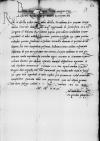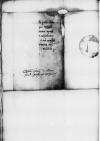Recoluimus his proxime elapsis diebus binas nos dedisse litter paper damaged⌈[e litter]e litter paper damaged⌉as magnifico Sigmund von Herberstein (*1486 – †1566), diplomat in the service of Emperor Maximilian I, Charles V, and Roman King Ferdinand I, writer and historian. In 1517 sent to Poland to conduct the marriage between King Sigismund I Jagiellon and Duchess Bona Sforza d'Aragona, and to Moscow to arrange a truce between the Grand Duchy of Muscovy and the Grand Duchy of Lithuania; 1515 member of the Council of the Holy Roman Empire, in 1515-1553 carried out many diplomatic missions (in 1517 and 1526 he was twice an imperial envoy at the Muscovy court)⌊Sigismundo de HerbersteinSigmund von Herberstein (*1486 – †1566), diplomat in the service of Emperor Maximilian I, Charles V, and Roman King Ferdinand I, writer and historian. In 1517 sent to Poland to conduct the marriage between King Sigismund I Jagiellon and Duchess Bona Sforza d'Aragona, and to Moscow to arrange a truce between the Grand Duchy of Muscovy and the Grand Duchy of Lithuania; 1515 member of the Council of the Holy Roman Empire, in 1515-1553 carried out many diplomatic missions (in 1517 and 1526 he was twice an imperial envoy at the Muscovy court)⌋, ut a serenissimo Ferdinand I of Habsburg (*1503 – †1564), from 1521 Archduke of Austria, from 1526 King of Bohemia and Hungary, Croatia and Slavonia as Ferdinand I, 1531-1558 King of the Romans, 1558-1564 Holy Roman Emperor; son of Philip I the Handsome and Joanna the Mad of Castile, a younger brother of Charles V of Habsburg⌊Hungariae et Bohemiae rege paper damaged⌈[ege]ege paper damaged⌉Ferdinand I of Habsburg (*1503 – †1564), from 1521 Archduke of Austria, from 1526 King of Bohemia and Hungary, Croatia and Slavonia as Ferdinand I, 1531-1558 King of the Romans, 1558-1564 Holy Roman Emperor; son of Philip I the Handsome and Joanna the Mad of Castile, a younger brother of Charles V of Habsburg⌋ litteras passus, quas salvum conductum vocant, expediret, et nobis mitteret paper damaged⌈[et]et paper damaged⌉ quam primum. Quarum praetextu sex equos partim valachos, partim gradarios in Italy (Italia)⌊ItaliamItaly (Italia)⌋ nonnullis dominis et personis de nobis bene meritis tuto transmittere possemus. Hactenus tamen nullum responsum habemus. De quo non possumus non mirari et quia audimus in oris Germanicis multa impedimenta euntibus ingeri, veremur, ne etiamnum equorum nostrorum ductori per aliquos officiales nonnihil difficultatis ingeratur et nostra desideria immorentur.
Volumus, ut
S(inceritas) or S(trenuitas)⌈S(inceritas)S(inceritas) or S(trenuitas)⌉
Tua apud eundem Ferdinand I of Habsburg (*1503 – †1564), from 1521 Archduke of Austria, from 1526 King of Bohemia and Hungary, Croatia and Slavonia as Ferdinand I, 1531-1558 King of the Romans, 1558-1564 Holy Roman Emperor; son of Philip I the Handsome and Joanna the Mad of Castile, a younger brother of Charles V of Habsburg⌊serenissimum regemFerdinand I of Habsburg (*1503 – †1564), from 1521 Archduke of Austria, from 1526 King of Bohemia and Hungary, Croatia and Slavonia as Ferdinand I, 1531-1558 King of the Romans, 1558-1564 Holy Roman Emperor; son of Philip I the Handsome and Joanna the Mad of Castile, a younger brother of Charles V of Habsburg⌋, dum Augsburg (Augusta Vindelicorum), city in Germany, Bavaria⌊AugustaeAugsburg (Augusta Vindelicorum), city in Germany, Bavaria⌋ erit, litteras huiusmodi pro traducendis tuto in Italy (Italia)⌊ItaliamItaly (Italia)⌋ sex equis nostris expediat et nobis easdem per primum ac certum occurrentem transmittat, factura nobis rem pergratam, qua nil ad praesens gratius.
Et bene feliciterque valeat S(inceritas) or S(trenuitas)⌈S(inceritas)S(inceritas) or S(trenuitas)⌉ Tua.


 BCz, 3465, p. 28
BCz, 3465, p. 28